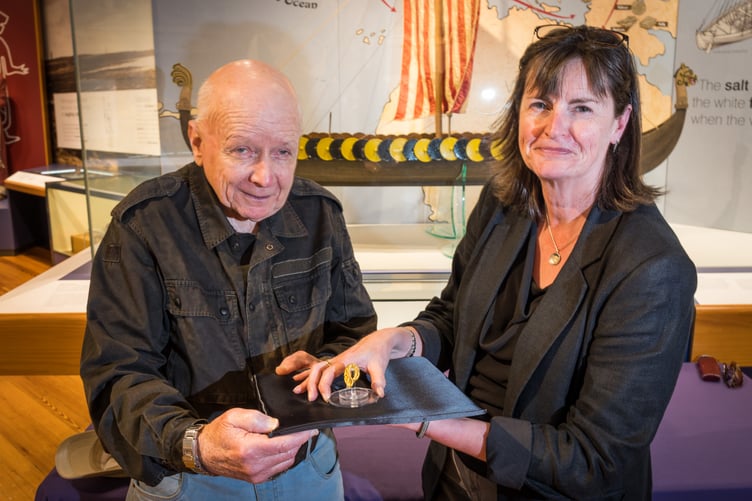A Manx metal detectorist has discovered rare Viking gold in the form of an arm ring.
The discovery of the island’s latest treasure hoard has ‘enhanced’ the island’s understanding of Viking history, and has now been declared treasure by the Isle of Man Deputy Coroner of Inquests.
The latest hoard consists of a rare fragment of gold arm ring which belonged to a Viking, who lived in the Isle of Man around one thousand years ago.
Discovered by metal detectorist and member of the Manx Detectorist Society Ronald Clucas in spring 2025, the find dates to around AD 1000-1100.
Created by plaiting eight strands of gold rods together, the arm-ring was made by a highly skilled goldsmith using a specialised technique.
The piece was found folded in two and is around 3.7cm in length, although it would have originally been roughly 7.7cm in length.
The fragment weighs 27.26g, a significant weight for a fragment of jewellery of it’s size.
‘It was quite a big shock to discover this lovely piece of gold, I couldn’t really believe it at first,’ said Mr Clucas.
‘Gold generally gives a very low signal on the detector, so you can’t really predict what is going to be uncovered.
‘I’ve been detecting for many years now and found some wonderful things, but to find a piece of gold from the Viking Age, that’s really something else.’
Allison Fox, curator for archaeology at Manx National Heritage, commented: ‘Jewellery items such as this had several functions in the Viking Age both as prized personal possessions and visible displays of wealth.
‘They were easily portable and were also used to cover costs in financial transactions.
‘During the Viking Age, there was a dual economy operating in the Isle of Man where both coins and bullion (silver and/or gold) were used to pay for goods and services.
‘Viking gold is much rarer compared to finds of silver from the same period, and it was usually used to create intricate pieces of jewellery.’
This fragment of gold arm-ring is the second find of Viking treasure discovered by Mr Clucas, who has been detecting for 50 years, with 2025 marking his golden anniversary of metal detecting.
Ronald’s earlier finds include a silver ingot and a lead ingot, which he discovered on the island in 2005.
‘This arm-ring has been cut twice, indicating it has possibly been used for at least two separate transactions,’ Allison added.
‘One cut removed the terminal end of the arm-ring, the other one cut the original complete arm-ring almost in half.
‘For reasons we will never know, this fragment of gold arm-ring was buried in the ground until discovered. It may have been hidden for safe-keeping, could just have been lost or may even have been buried as an offering to the Viking Gods.’
Manx National Heritage has thanked the finder Mr Clucas and the landowner for their help with the find, as well as Dr Kristin Bornholdt Collins and Professor James Graham-Campbell for sharing their expertise.



.jpeg?width=209&height=140&crop=209:145,smart&quality=75)
